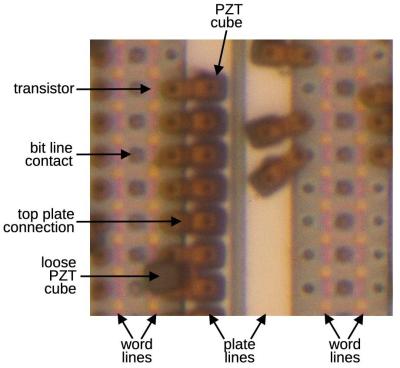
Although not as prevalent as Flash memory storage, ferroelectric RAM (FeRAM) offers a range of benefits over the former, mostly in terms of endurance and durability, which makes it popular for a range of (niche) applications. Recently [Ken Shirriff] had a look inside a Ramtron FM24C64 FeRAM IC from 1999, to get an idea of how it works. The full die photo can be seen above, and it can store a total of 64 kilobit.
One way to think of FeRAM is as a very small version of magnetic core memory, with lead-zirconate-titanate (PZT) ferroelectric elements making up the individual bits. These PZT elements are used as ferroelectric capacitors, i.e. the ferroelectric material is the dielectric between the two plates, with a positive voltage storing a ‘1’, and vice-versa.
In this particular FeRAM chip, there are two capacitors per bit, which makes it easier to distinguish the polarization state and thus the stored value. Since the distinction between a 0 and a 1 is relatively minor, the sense amplifiers are required to boost the signal. After a read action, the stored value will have been destroyed, necessitating a write-after-read action to restore the value, all of which adds to the required logic to manage the FeRAM. Together with the complexity of integrating these PZT elements into the circuitry this makes these chips relatively hard to produce and scale down.
You can purchase FeRAM off-the-shelf and research is ongoing, but it looks to remain a cool niche technology barring any kind of major breakthrough. That said, the Sega Sonic the Hedgehog 3 cartridges which used an FeRAM chip for save data are probably quite indestructible due to this technology.
















Well that was an education, I’d never even heard of FeRAM!
First chip I ever decapped was one of these, out of a Sonic the Hedgehog 3 cartridge for the Sega Genesis. Good times, and a good repair.
And good game!
FeRAM is still popular in automotive for nonvolatile parameters that are frequently updated like engine hours or the odometer.
I was wondering just what niches these fit into…
That is, not frequently updated, or frequently read data, but requiring outstanding durability.
I remember when TI had various LaunchPad kits for $5, I got one of their FRAM boards to play with. Looks like they still have it but a bit pricier
The Launchpad boards are more expensive than they used to be, but their FRAM-based MSP430s are often cheaper than a plain FRAM chip of the same capacity. I think the bare FRAM is faster, though.
I have a a couple, will have to take a look at this, thanks for the reminder!
“One way to think of FeRAM is as a very small version of magnetic core memory,…”
“These PZT elements are used as ferroelectric capacitors, i.e. the ferroelectric material is the dielectric between the two plates, with a positive voltage storing a ‘1’, and vice-versa.”
So which is it? Is a bit stored as magnetization or as a charge?
If the latter, then why would you think of FeRAM as a “small version of magnetic core memory?” Because it’s nonvolatile? By that definition, flash and battery-backed sram are also “small versions of core memory.”
It’s the logistics of the technology that’s like core, not the physics. Reading destroys the data like core.
It’s electric, not magnetic, but operates much more like core memory than like other electrostatic RAM (i.e. DRAM where the bit is represented by a capacitor being charged or not).
Ferroelectric materials retain electric polarization. That doesn’t mean a capacitor with ferroelectric material between the plates holds a voltage indefinitely. But the charge that flows while charging a capacitor from zero voltage depends on the polarization left from the last time it was charged — charge it with the same polarity as before and it will take fewer electrons; the opposite polarity will take more as the material’s polarization flips.
If you remember core memory, that should sound familiar — you test the polarization of the ferro-something-ic material by forcing it to one state and measure whether it changed along the way or not. That means reads are destructive, and data has to be rewritten. Core memory does it with pulses of current in wires threaded through ferrite rings, FeRAM does it with pulses of voltage on capacitors filled with PZT.
(which is all explained if you RTFA, but who does that)
Your comment on how these work was way more descriptive than the article.
Thank you.
These are great for replacing those Dallas NVSRAM chips with the potted coin cell.
Often you just need a DIP to SMT adapter board and they can plug straight in.
I’ve done it in a number of Tek scopes and other instruments, works flawlessly so far.
The FRAM used to be available as a DIP chip that was a direct swap, but they are obsolete now too, just like many of the Dallas chips…
I have some of them. They are nice in devices, whose power source is not reliable. I’m using them in for example GPS trackers.
I’ve been using 256Kbit (32KB) FeRAM chips to replace the old battery backed SRAM in Gameboy games. Now they will retain save data without power for beyond my lifetime.